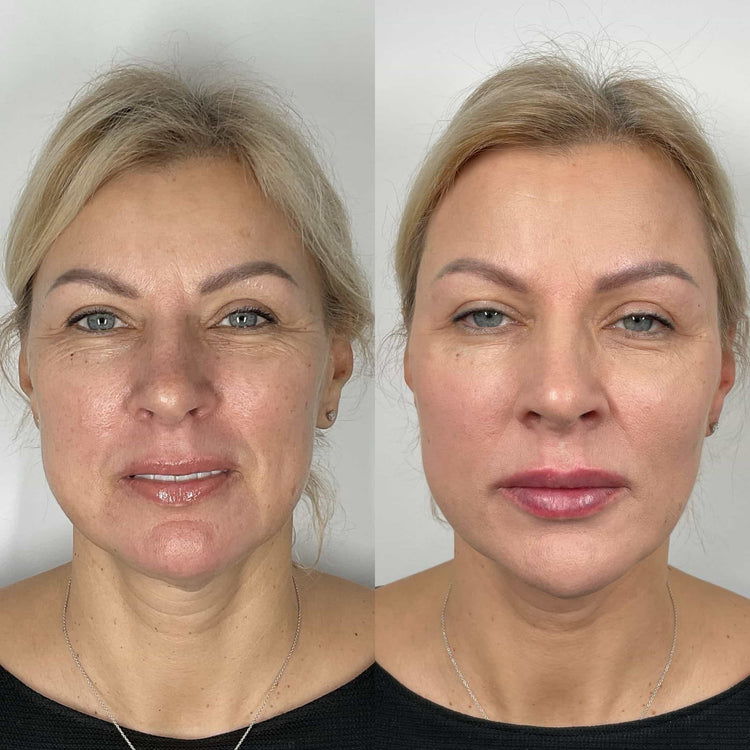Radiesse
Facial rejuvenation procedures are increasingly popular, with individuals seeking ways to address age-related volume loss and restore a youthful appearance. Two common approaches for achieving this goal are Radiesse liquid facelifts and fat transfer. Each technique offers distinct advantages and considerations, making it crucial to understand their differences to determine the most suitable option for individual needs.
Procedure
Radiesse is a dermal filler composed of calcium hydroxylapatite microspheres suspended in a gel carrier. It’s injected into areas where volume has been lost, such as cheeks, temples, and jawline, stimulating collagen production and providing immediate lift and contouring. Radiesse also has a volumizing effect that lasts longer than many other hyaluronic acid fillers, typically lasting around 12-18 months.
Fat transfer involves surgically harvesting fat from one area of the body, processing it, and injecting it into facial areas needing volume restoration. Fat grafting can provide long-lasting results as the transplanted fat cells integrate with existing tissue. However, it’s a more invasive procedure requiring anesthesia and carries potential risks like swelling, infection, and asymmetry.
The choice between Radiesse and fat transfer depends on factors like desired outcome, budget, and individual preferences. Radiesse offers a less invasive, quick solution with longer-lasting results than some hyaluronic acid fillers. Fat transfer provides potentially permanent volume restoration but involves surgery with associated risks and recovery time.
Recovery Time
Recovery time is a key factor to consider when comparing Radiesse and fat transfer.

- Radiesse injections are typically a quick in-office procedure with minimal downtime. Most patients can return to their normal activities immediately after treatment.
- Fat transfer, being a surgical procedure, requires more recovery time. Patients may experience swelling, bruising, and tenderness for several weeks post-surgery. It often takes several weeks to fully recover and see the final results.
Longevity
When comparing Radiesse liquid facelifts and fat transfer for facial volume in Kingston Upon Thames, recovery time is a crucial consideration.
Radiesse injections are minimally invasive, with patients generally able to return to their daily activities immediately after the procedure.
Fat transfer, on the other hand, is a surgical procedure requiring a longer recovery period. Swelling, bruising, and tenderness are common side effects that can last for several weeks, and it may take several weeks before the final results are fully visible.
Fat Transfer
Facial rejuvenation procedures have become increasingly sought after, with individuals looking to combat age-related volume loss and regain a youthful appearance. Two popular methods for achieving this goal are Radiesse liquid facelifts and fat transfer.
Procedure
Fat transfer is a surgical procedure that involves harvesting fat from one area of the body, processing it, and injecting it into facial areas where volume is desired. This technique utilizes the patient’s own fat, offering potential for long-lasting results as the transplanted fat cells integrate with the recipient tissue.
The process typically begins with liposuction to extract fat from areas like the abdomen, thighs, or buttocks. The extracted fat is then purified and prepared for injection. Using a cannula, the processed fat is carefully injected into specific facial areas such as cheeks, temples, or under the eyes to restore volume and enhance contours.
While fat transfer can provide natural-looking results that often last for years, it’s considered a more invasive procedure compared to non-surgical options like Radiesse. It requires anesthesia, carries risks such as swelling, infection, and asymmetry, and necessitates a recovery period with potential limitations on activity.
Recovery Time
Fat transfer is a surgical procedure that involves harvesting fat from one area of the body and injecting it into facial areas needing volume restoration. Recovery time for fat transfer is typically longer compared to non-surgical procedures like Radiesse injections.
Patients may experience swelling, bruising, and tenderness for several weeks after the procedure. It often takes several weeks to fully recover and see the final results as the transplanted fat cells integrate with existing tissue.
Longevity
Facial rejuvenation is a popular pursuit, with individuals seeking methods to restore youthful volume in the face. Two commonly discussed options are Radiesse liquid facelifts and fat transfer. Understanding their distinct characteristics can help individuals make informed decisions about the best approach for their needs.
- Radiesse, a dermal filler composed of calcium hydroxylapatite microspheres, is injected into areas like cheeks, temples, and jawline. It stimulates collagen production, providing immediate lift and contouring that typically lasts 12-18 months.
- Fat transfer involves surgically harvesting fat from another part of the body, processing it, and injecting it into facial areas. This can provide potentially permanent volume restoration as the transplanted fat cells integrate with existing tissue.
While Radiesse offers a quick, minimally invasive procedure with longer-lasting results than some hyaluronic acid fillers, fat transfer provides potentially permanent volume restoration but requires surgery and carries associated risks and recovery time.
Potential Risks and Complications

Fat transfer, while offering the potential for long-lasting, natural-looking results, comes with inherent risks and complications. As with any surgical procedure, there’s a risk of infection, bleeding, and adverse reactions to anesthesia.
One potential concern is asymmetry, where the transferred fat doesn’t distribute evenly, leading to an unbalanced appearance.
Additionally, some of the transplanted fat may be absorbed by the body, meaning not all injected fat will survive and contribute to long-term volume enhancement. This can lead to a less dramatic or desired outcome.
Swelling and bruising are common side effects that can persist for weeks following surgery and may impact daily activities.
Careful patient selection, meticulous surgical technique by an experienced practitioner, and realistic expectations are crucial for minimizing risks and maximizing the success of fat transfer procedures.
- Tinkerbell Nose Tip Lift Treatment Near Hook, Surrey - December 6, 2025
- The Science Behind The Craftsman Series Vape’s Smooth Hits - December 5, 2025
- The Legal Status Of CBD Gummy Edibles In The UK - December 2, 2025
